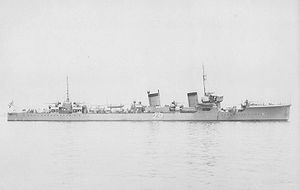Japanese destroyer Fumizuki (1926)
 Fumizuki in July 1926
| |
| History | |
|---|---|
| Name | Fumizuki |
| Namesake | July |
| Builder | Fujinagata Shipyards, Osaka |
| Laid down | 20 October 1924 as Destroyer No. 29 |
| Launched | 16 February 1926 |
| Completed | 3 July 1926 |
| Renamed | As Fumizuki, 1 August 1928 |
| Stricken | 31 March 1944 |
| Fate | Sunk by American aircraft, 18 February 1944 |
| General characteristics | |
| Class and type | Mutsuki-class destroyer |
| Displacement |
|
| Length |
|
| Beam | 9.16 m (30 ft 1 in) |
| Draft | 2.96 m (9 ft 9 in) |
| Installed power |
|
| Propulsion | 2 shafts; 2 × Kampon geared steam turbines |
| Speed | 37.25 knots (68.99 km/h; 42.87 mph) |
| Range | 4,000 nmi (7,400 km; 4,600 mi) at 15 knots (28 km/h; 17 mph) |
| Complement | 150 |
| Armament |
|
| Service record | |
| Part of: | Destroyer Division 30 |
| Operations: |
|
Fumizuki (文月, ”July”) was one of twelve
Design and description
The Mutsuki class was an improved version of the
The main armament of the Mutsuki-class ships consisted of four
Fumizuki was one of six Mutsuki-class ships reconstructed in 1935–36, with their hulls strengthened, raked caps fitted to the funnels and shields to the torpedo mounts. In 1941–42, most of those ships were converted into fast transports with No. 2 and No. 3 guns removed. In addition, ten license-built
Construction and career
Fumizuki, built at the
Pacific War
At the time of the
In early 1942, Fumizuki was assigned to escorting troop convoys from
On 16 September, Fumizuki sustained heavy damage after a collision with the transport
At the end of January 1943, Fumizuki escorted the
Fumizuki returned to
While at Truk on 17 February 1944, Fumizuki received a near miss bomb from a
In media
- "Graveyard of the Atlantic...Graveyard of the Pacific," a 1991 episode of the PBS television series Return to the Sea, includes footage of a dive on the wreck of Fumizuki.
Notes
References
- Bailey, Dan E. (1992). World War II: Wrecks of the Kwajalein and Truk Lagoons. North Valley Diver Publications. ISBN 0-911615-05-9.
- Chesneau, Roger, ed. (1980). Conway's All the World's Fighting Ships 1922-1946. Greenwich: Conway Maritime Press. ISBN 0-85177-146-7.
- Howarth, Stephen (1983). The Fighting Ships of the Rising Sun: The Drama of the Imperial Japanese Navy, 1895–1945. Atheneum. ISBN 0-689-11402-8.
- Jentschura, Hansgeorg; Jung, Dieter & Mickel, Peter (1977). Warships of the Imperial Japanese Navy, 1869–1945. Annapolis, Maryland: United States Naval Institute. ISBN 0-87021-893-X.
- Lindemann, Klaus (2005). Hailstorm Over Truk Lagoon: Operations Against Truk by Carrier Task Force 58, and the Shipwrecks of World War II. Oregon, USA: Resource Publications. ISBN 1-59752-347-X.
- Nevitt, Allyn D. (1998). "IJN Fumizuki: Tabular Record of Movement". Long Lancers. Combinedfleet.com. Retrieved 10 November 2015.
- Watts, Anthony J. & Gordon, Brian G. (1971). The Imperial Japanese Navy. Garden City, New York: Doubleday. ISBN 0385012683.
- Whitley, M. J. (1988). Destroyers of World War Two. Annapolis, Maryland: Naval Institute Press. ISBN 0-87021-326-1.
